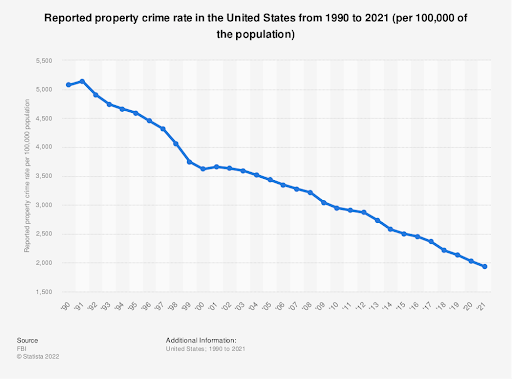Residential Property Crime in the United States

Crime impacts us all. But while violent crimes get most of our attention and concern, you’re far more likely to be the victim of property crime. About 5.5x more likely, in fact.
Property crime–including larceny/theft, burglary, motor vehicle theft, and arson–is the most common type of crime in the United States by far. The second and third most frequent are drug-related and alcohol-related, respectively, followed by violent at a distant fourth.
FBI data reveals that a violent crime is reported every 22 seconds on average. Property crime? Every three seconds.
It’s not all bad news, though. Let’s dive into some property crime facts and statistics.
Macro Trends in Property Crime
Despite still being the most prevalent type of crime, the property crime rate has been consistently falling since its peak in the early 1990s.
There were 51.4 property crimes per 1,000 American citizens in 1991. That figure dropped to 19.3 per 1,000 in 2021. Violent crimes have witnessed a similar downward trend over that same period.

According to the FBI, the property crime rate fell by 55% between 1993 and 2019. The Bureau of Justice Statistics (BJS) puts that drop at 71%. No matter what way you slice it, that’s a significant decrease.
Sadly, though, there are still millions of reported property crimes across the country each year. And likely millions more that go unreported.
The Big Picture
The overall property crime rate in the United States is 1,99.3 per 1,000 as of 2021. That number may be higher or lower depending on where you live (more on that later). But that number doesn’t even give the full picture, as experts estimate that only about one-third of property crimes are reported to authorities.
By type, the most common property crime is larceny/theft. As a snapshot, the reported property crimes in 2019 broke down as follows:
- Larceny/theft – 5,086,096 cases
- Burglary – 1,117,696 cases
- Motor vehicle theft – 721,000+ cases
- Arson – 32,358 cases
And while it can happen anywhere, about 66% of property crime occurs at residential properties: homes, apartments, cabins, condos, cottages, and more. Are you protected from residential property crime?
If not, you should be. The recovery rate for stolen property is an abysmal 31.1% nationwide. It’s a bit better for vehicles and household goods–56.4% and 39%, respectively–but a minuscule 3% for jewelry and precious metals.
Property crime costs topped out at $15.8 billion in 2019, mostly the result of theft. But the average loss from a residential burglary is $7,937 (and $9,779 for non-residential locations). That’s not an insignificant amount. And not a cost many people can absorb without warning.
Property Crime by State
Some places are always going to be safer than others. That’s true for violent crime and property crime.
We can look at the total number of cases, or we can look at the per capita crime rate. The top and bottom five may differ depending on which statistic is used, but it’s good to compare and get some perspective. All of this comes with a few significant caveats: reported crimes are only one part of the picture, reporting standards are not universal, and crime is a complex sociological phenomenon that only serves as one indicator of safety.
Total Cases
By the total number of reported cases, the top five states for property crime in 2021 were:
- Texas – 946,717
- Washington – 357,551
- North Carolina – 337,746
- Colorado – 295,735
- Ohio – 288,592
The states with the fewest reported cases in that same year were:
- South Dakota – 21,932
- Vermont – 13,817
- Wyoming – 10,750
- Alaska – 7,301
- Florida – 969
With Florida as the obvious outlier–it’s the third most populous state–those places with the fewest reported cases tend to be much less populous than those with the most cases. Deep Sentinel’s home state of California, for the sake of comparison, came in at 29th with 81,313 reported cases.
Per Capita
The property crime rate per 1,000 residents provides a more accurate picture, though. By that criterion, the top five states for property crime in 2020 were:
- District of Columbia – 34.9 per 1,000 residents
- Louisiana – 28.9
- New Mexico – 28.4
- Colorado – 28.3
- Washington – 27.3
The states with the lowest property crime rate that same year were:
- Massachusetts – 10.5 per 1,000 residents
- New Hampshire – 11.0
- Idaho – 11.1
- Maine – 11.6
- New Jersey – 11.6
California had the 19th highest rate at 21.4 per 1,000 residents.
Property Crime by City
Small towns are generally safer than big cities. But that’s not to say you can become complacent if you live in a tiny town. Crime is everywhere.
To that end, we’ll break down a few categories by population size to compare crime among similar-sized cities.
Populations of 500,000+
The overall property crime rate in cities with more than 500,000 people is 32.6 per 1,000 residents.
The top three major cities for burglary are:
- Seattle – 13.5 per 1,000 residents
- Albuquerque – 9.0
- Memphis – 9.0
The top three for motor vehicle theft are:
- Portland – 5.7 per 1,000 residents
- Denver – 5.3
- Albuquerque – 5.1
Populations Between 250,000 and 499,999
The overall property crime rate for cities in this range is 28.8 per 1,000 residents.
The top three for burglary are:
- Tulsa – 11.0 per 1,000 residents
- Cleveland – 9.7
- Minneapolis – 9.0
And the top three for motor vehicle theft:
- Oakland – 15.3 per 1,000 residents
- St. Louis – 10.8
- Aurora, Colorado – 10.2
Populations Between 10,000 and 99,999
At the other end of the spectrum, the overall property crime rate for small cities and towns is 19.0 per 1,000 residents.
The top three for burglary are:
- Laurinburg, North Carolina – 2,690.4 per 100,000 residents
- El Dorado, Arkansas – 2,071.6
- Opelousas, Louisiana – 2,060.7
And the top three for motor vehicle theft:
- Commerce, California – 2,832.1 per 100,000 residents
- Fife, Washington – 2,757
- Tukwila, Washington – 2,587.5
You can escape a lot of things by moving from a large city to a smaller one. But that doesn’t include crime.
Residential Property Crime
When it comes to residential property crime, you’re most likely to encounter either theft or burglary.
But what’s the difference, if anything, between theft and burglary? And robbery, for that matter? Here’s a very, very simplified breakdown:
- Theft involves taking something. It’s a crime against a thing.
- Burglary is entering a property without permission. It’s a crime against a place.
- Robbery is the most serious because it involves force or the threat of force. It’s a crime against a person.
There are over one million reported burglary cases in the US every year. And the majority of those are against residential properties.
In fact, there were 416,151 reported burglaries at residential homes in 2021. The next highest location? Rental storage facilities at 40,351. Commercial/office buildings (39,854), specialty stores (20,421), and parking garages or lots (19,338) rounded out the top five.
A burglary can be further divided into forced entry (breaking in), unlawful entry (entering via an unlocked door, for example), and attempted forced entry (although this one isn’t a subtype of burglary everywhere).
Burglary: Fast Facts
- Experts predict that 75% of American homes will have been the victim of burglary by 2039. An even more sobering statistic is that 51% of burglarized homes suffer a second burglary within a month. It’s believed that burglars wait for the homeowner to replace stolen items and return to take the replacements.
- Roughly 65% of reported burglaries happen between 6 am and 6 pm while most people are at work. Residential daytime burglary is the biggest segment, followed by residential night burglaries, then nonresidence day burglaries, and finally nonresidence night burglaries.
- Would-be burglars use a variety of entry points. The most common is the front door at 34%, while 22% opt for the back door. Make sure you secure your door from being kicked in or broken. A sliding glass door is an obvious weak spot, so explore glass door security options. Another 23% head straight for a ground-floor window; secure your windows as much as possible. And lest you think the second floor is safe, 2% of burglars will attempt entry there.
- The police only solve about 13% of reported cases. Better to take proactive, preventative steps.
- Renters are more likely to be burgled than homeowners, with 2-4 unit apartment buildings being the most targeted. (Check out our apartment security tips to stay safe.)
- Students, followed by senior citizens, are victims of burglary more than any other group. (We have safety tips for seniors, too.)
- Your residential property is 300% less likely to be targeted if you have a security system installed. Yard signs and window decals are a simple way to tell criminals it’s there.
- Home burglaries last on average between 8-10 minutes–although some are less than 90 seconds!
- A residential property is burgled every 13 seconds.
Don’t become a statistic.
Protect What’s Yours from Residential Property Crime
How? With Deep Sentinel.
The property crime rate is 21.9 per 1,000 residents in metropolitan statistical areas, 25.0 in cities outside metropolitan areas, and 10.3 in non-metropolitan areas. That’s too high no matter where you live.
But with a combination of home security cameras, artificial intelligence, and live surveillance guards, Deep Sentinel can provide unparalleled proactive protection, day in and day out. Guards can engage and intervene via 2-way audio, which is often enough to send suspicious individuals scurrying away before committing a crime. If and when police intervention is necessary, guards notify them in 30 seconds or less. And because it’s a verified crime in progress, the authorities prioritize their response.
That’s true protection at home… regardless of where home might be.
Need a Solution that Prevents Crime?
Deep Sentinel is the only security technology that delivers the experience of a personal guard on every customer’s home and business. Visit deepsentinel.com or call 833-983-6006

